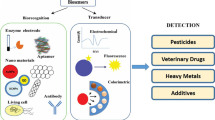Abstract
With the modernization of dietary conceptions, people begin to treat various crops flour as health diet. Unfortunately, species adulteration of flour becomes more and more serious while it is difficult to identify them by the naked eye. Therefore, a reliable molecular biological method of species authentication for common crops flour is required by consumers and authorities. This study developed a reliable and rapid system for detecting six common crops flour (wheat flour, corn flour, potato flour, pea powder, soybean powder and rice flour) using optical silicon thin-film biosensor chips. Aldehyde-labeled capture probes (specific nuclear fragments of endogenous genes of the six food species) were covalently attached to amino-functionalized optical surfaces. Samples containing biotinylated target nucleic acids (PCR amplicon) were then hybridized to this surface. Following hybridization, the immobilized target sequence is incubated with an anti-biotin IgG-horseradish peroxidase conjugate and a precipitable horseradish peroxidase substrate. After incubation, a thin film would be deposited on the chip surface. The mass contributed by the thin film causes a color change visible to the naked human eyes. Using this method, we successfully identified these six food powders. This assay is easy, sensitive, accurate, suitable and can potentially be used as a high throughput for the specific foodstuffs qualitative detection.



Similar content being viewed by others
References
Ross M, Jackson L (2012) Summary of the ACS symposium on advances in food allergen detection. J Agric Food Chem. doi:10.1021/jf304327d
Arlorio M, Cereti E, Coïsson JD, Travaglia F, Martelli FA (2007) Detection of hazelnut (Corylus spp.) in processed foods using real-time PCR. Food Control 18:140–148
Hernández M, Esteve T, Pla M (2005) Real-time polymerase chain reaction based assays for quantitative detection of barley, rice, sunflower, and wheat. J Agric Food Chem 53:7003–7009
Brownie J, Shawcross S, Theaker J, Whitcombe D, Ferrie R, Newton C, Little S (1997) The elimination of primer–dimer accumulation in PCR. Nucleic Acids Res 25:3235–3241
Büren M, Stadler M, Lüthy J (2001) Detection of wheat adulteration of spelt flour and products by PCR. Eur Food Res Technol 212:234–239
Ding J, Jia J, Yang L, Wen H, Zhang C, Liu W, Zhang D (2004) Validation of a rice specific gene, sucrose phosphate synthase, used as the endogenous reference gene for qualitative and real-time quantitative PCR detection of transgenes. J Agric Food Chem 52:3372–3377
Brodmann PD, Ilg EC, Berthoud H, Herrmann A (2002) Real-time quantitative polymerase chain reaction methods for four genetically modified maize varieties and maize DNA content in food. J AOAC Int 3:85–89
Ramos-Gómez S, López-Enríquez L, Caminero C, Hernández M (2008) Pea detection in food and feed samples by a real-time PCR method based on a specific legumin gene that allows diversity analysis. J Agric Food Chem 56:11098–11104
Randhawa GJ, Singh M, Sharma R (2009) Validation of ST-LS1 as an endogenous reference gene for detection of AmA1 and cry1Ab genes in genetically modified potatoes using multiplex and real time PCR. Am J Pot Res 86:398–405
Zhang L, Cao Y, Liu X, Wu G, Wu Y, Lu C (2012) In-depth analysis of the endogenous reference genes used in the quantitative PCR detection systems for rice. Eur Food Res Technol 234:981–993
Hahnen S, Offermann S, Miedl B, Rüger B, Peterhänsel B (2002) Automated DNA preparation from maize tissues and food samples suitable for real-time PCR detection of native genes. Eur Food Res Technol 215:443–446
Mbella E, Lievens A, Barbau-Piednoir E, Sneyers M, Leunda-Casi A, Roosens N, Bulcke M (2011) SYBR®Green qPCR methods for detection of endogenous reference genes in commodity crops: a step ahead in combinatory screening of genetically modified crops in food and feed products. Eur Food Res Technol 232:485–496
Handy S, Timme R, Jacob S, Deeds J (2013) Development of a locked nucleic acid real-time polymerase chain reaction assay for the detection of Pinus armandii in mixed species pine nut samples associated with dysgeusia. J Agric Food Chem. doi:10.1021/jf304223a
Baric S, Kerschbamer C, Dalla VJ (2006) TaqMan real-time PCR versus four conventional PCR assays for detection of apple proliferation phytoplasma. Plant Mol Biol Rep 24:169–184
Bai S, Zhang J, Li S, Zhang X, Chi X, Tian J, Chen H, Luo H, Chen Y, Zhang Y (2010) Detection of six genetically modified maize on optical thin-film biosensor chips. J Agric Food Chem 58:8490–8494
Xu L, Bai S, Guo X, Zhang Y, Deng Y, Huang W, Chen Y, He Y (2012) A rapid approach for detecting seven genetically modified canola events using optical thin-film biosensor chips. J Biochips Tissue Chips. doi:10.4172/2153-0777.1000101
Bai S, Li S, Yao T, Hu Y, Bao F, Zhang J, Zhang Y, Zhu S, He Y (2011) Rapid detection of eight vegetable oils on optical thin-film biosensor chips. Food Control 22:1624–1628
Bai S, Zhong X, Ma L, Zheng W, Fan L, Wei N, Deng XW (2007) A simple and reliable assay for detecting specific nucleotide sequences in plants using optical thin-film biosensor chips. Plant J 49:354–366
Zhong X, Reynolds R, Kidd JR, Kidd KK, Jenison R, Marlar RA, Ward DC (2003) Single-nucleotide polymorphism genotyping on optical thin-film biosensor chips. Proc Natl Acad Sci 100:11559–11564
Jenison R, Yang S, Haeberli A, Polisky B (2001) Interference-based detection of nucleic acid targets on optically coated silicon. Nat Biotech 19:757–761
Acknowledgments
This work was supported by Beijing Municipal Education Commission (KM201110028010), Natural Science Foundation of China (30771094, 31270821), Beijing Natural Science Foundation (5112006).
Conflict of interest
The authors have declared no conflict of interest.
Compliance with Ethics Requirements
This article does not contain any studies with human or animal subjects.
Author information
Authors and Affiliations
Corresponding authors
Additional information
Sulan Bai and Liang Xu contributed equally to this work.
Rights and permissions
About this article
Cite this article
Bai, S., Xu, L., Wang, Y. et al. A simple and reliable qualitative detection of six foodstuff powders using optical thin-film biosensor chips. Eur Food Res Technol 236, 899–904 (2013). https://doi.org/10.1007/s00217-013-1940-y
Received:
Revised:
Accepted:
Published:
Issue Date:
DOI: https://doi.org/10.1007/s00217-013-1940-y




